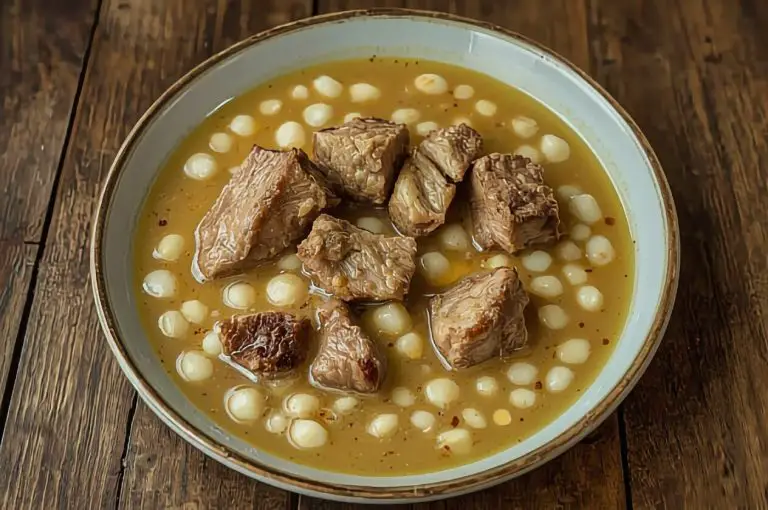The Bolivian Fricassee recipe is a classic dish that really shows off the depth of Bolivian food—a hearty stew loaded with pork, white corn, and a punchy mix of spices. This dish is all about savory flavors and a satisfying, stick-to-your-ribs texture. It’s a staple at celebrations and family gatherings across Bolivia. Its roots dig deep into traditional Andean cooking, where humble local ingredients come together for something truly memorable.
Honestly, making this recipe at home brings a little slice of Bolivian tradition right into your kitchen. When you simmer pork ribs with mote (white corn) and bold spices like ají amarillo, you get a stew that’s both simple to make and surprisingly complex in flavor. It’s the sort of meal that feels comforting and a bit adventurous at the same time.
Key Takeaways
- Bolivian Fricassee mixes pork, corn, and spices into a deeply flavorful stew.
- The steps are pretty straightforward, but the long simmer makes everything melt-in-your-mouth good.
- This dish is a favorite in Bolivia, especially for special occasions and big family meals.
Bolivian Fricassee Recipe Ingredients
Servings: 8
Prep Time: 40 Minutes
Cooking Time: 1 Hour 30 Minutes
4 lb pork ribs
2 cups white corn, (mote)
1 tsp ají amarillo paste
1 tbsp cumin
1 tsp black pepper
1 tsp oregano
4 cloves garlic, minced
1/4 tsp salt, to taste
Chuño (freeze-dried potato), to serve
Fresh mint or cilantro, for garnish (optional)

Bolivian Fricassee Recipe Cooking Instructions
Start by washing and cutting the pork ribs into pieces. Rub them all over with Carne Asada seasoning and let them marinate—30 minutes is good, but longer is even better if you have time.
While the ribs soak up flavor, get the mote going. Boil the white corn in a big pot of water for about 30 minutes, or until it’s tender. Drain it and set it aside.
Heat some oil in a large skillet. Toss in the minced garlic, some sliced white onion, and chopped green onion. Sauté until everything’s soft and just starting to caramelize.
In a small bowl, stir together the ají amarillo paste, ancho powder (if you have it), cumin, paprika, and black pepper. It’ll smell incredible.
Crank up the heat under your skillet and sear the pork ribs until they’re browned on every side. Turn the heat down to medium-low, then add your spice mixture. Make sure the ribs get coated all over with those spices.
Add the cooked mote to the skillet and gently stir it all together.
Cover the skillet and let everything simmer on low heat for 1 to 1.5 hours. Give it a stir every now and then so nothing sticks. When the pork is fork-tender and the flavors have melded, you’re done.
Spoon the Fricassee into bowls and serve hot, with a side of chuño or whatever you like. A sprinkle of fresh cilantro or mint on top adds a nice touch.
RECIPE CARD GOES HERE

Bolivian Fricassee Recipe
Ingredients
- 4 lb pork ribs
- 2 cups white corn (mote)
- 1 tsp ají paste amarillo
- 1 tbsp cumin
- 1 tsp black pepper
- 1 tsp oregano
- 4 cloves garlic minced
- 1/4 tsp salt to taste
- Chuño freeze-dried potato, to serve
- Mint or cilantro for garnish (optional)
Instructions
- Start by washing and cutting the pork ribs into pieces. Rub them all over with Carne Asada seasoning and let them marinate—30 minutes is good, but longer is even better if you have time.
- While the ribs soak up flavor, get the mote going. Boil the white corn in a big pot of water for about 30 minutes, or until it’s tender. Drain it and set it aside.
- Heat some oil in a large skillet. Toss in the minced garlic, some sliced white onion, and chopped green onion. Sauté until everything’s soft and just starting to caramelize.
- In a small bowl, stir together the ají amarillo paste, ancho powder (if you have it), cumin, paprika, and black pepper. It’ll smell incredible.
- Crank up the heat under your skillet and sear the pork ribs until they’re browned on every side. Turn the heat down to medium-low, then add your spice mixture. Make sure the ribs get coated all over with those spices.
- Add the cooked mote to the skillet and gently stir it all together.
- Cover the skillet and let everything simmer on low heat for 1 to 1.5 hours. Give it a stir every now and then so nothing sticks. When the pork is fork-tender and the flavors have melded, you’re done.
- Spoon the Fricassee into bowls and serve hot, with a side of chuño or whatever you like. A sprinkle of fresh cilantro or mint on top adds a nice touch.
Notes
Nutrition
Cooking Tips
Marinating the pork ribs ahead of time really makes a difference. If you can let them sit overnight in the fridge, do it. That flavor gets deep into the meat.
Searing the ribs first gives them a great crust and locks in the juices. Don’t skip this step—it’s worth it.
Play around with the spices. Cumin and ají amarillo are key, but you can adjust the heat or smokiness to your taste.
Cook the mote separately so it gets tender without turning the pork to mush. Drain it well before tossing it into the stew.
Keep the simmer low and slow. Stir every so often and let the flavors do their thing.
If you have a meat thermometer handy, check that the pork hits at least 145°F (63°C) inside. Safety first.
Chopped cilantro or mint right before serving brightens everything up. It’s optional, but I like the freshness.
Short on time? Use pre-cooked mote or cook the corn the day before. Leftovers keep well in an airtight container for a few days, though honestly, it’s usually gone by then.
Bolivian Fricassee Recipe FAQs
The Bolivian fricassee recipe takes a bit of care—good pork, the right spices, and enough cooking time to get everything just right. It’s usually served with sides that round out the meal, and you can tweak the recipe to fit your preferences or dietary needs.
How do I properly prepare the pork for a traditional Bolivian fricassee recipe?
Go for pork ribs—they give you the best flavor and texture for the Bolivian fricassee recipe. Wash and cut them into pieces, then marinate with Carne Asada seasoning for at least 30 minutes. Longer is even better.
What are the essential spices needed for an authentic Bolivian fricassee recipe flavor?
You’ll want ají amarillo paste (dried if you can find it), ancho powder, cumin, paprika, black pepper, and garlic for the Bolivian fricassee recipe. This combo gives you that smoky, slightly spicy, unmistakably Bolivian taste.
Can you list the typical sides served with the Bolivian fricassee recipe?
Chuño (freeze-dried potatoes) is the classic, but you’ll also see steamed white rice, avocado salad with lime, or some crusty bread when serving the Bolivian fricassee recipe. These sides help balance the rich flavors of the stew.
What is the recommended cooking time for the Bolivian fricassee recipe to ensure tenderness?
Let it simmer for about 1 to 1.5 hours on low for your Bolivian fricassee recipe. That’s enough time for the pork to get super tender and for the flavors to come together.
Are there any common variations of the Bolivian fricassee recipe from different regions of Bolivia?
Definitely. Some regions swap in aji colorado (hot red chilies) instead of ají amarillo, or add bread crumbs to thicken things up. Every family seems to have their own twist when it comes to their Bolivian fricassee recipe.
How can I adapt the Bolivian Fricassee recipe for dietary restrictions, such as vegetarian or gluten-free?
Honestly, tweaking the Bolivian fricassee recipe for dietary needs isn’t as tough as it sounds. If you’re vegetarian, just swap out the pork for mushrooms or textured vegetable protein—that combo brings a nice, hearty texture. Go with a veggie broth instead of the usual. For gluten-free folks, ditch the mote and try quinoa or another gluten-free grain you like. Double-check your spices and pastes; sometimes gluten sneaks in where you least expect it. And of course, season everything to your liking. Cooking should fit your needs, not the other way around.

